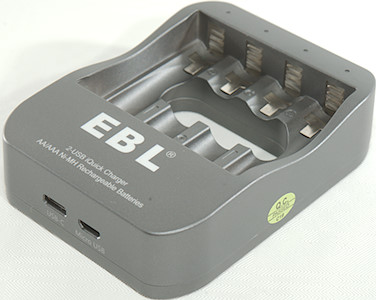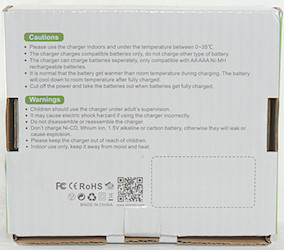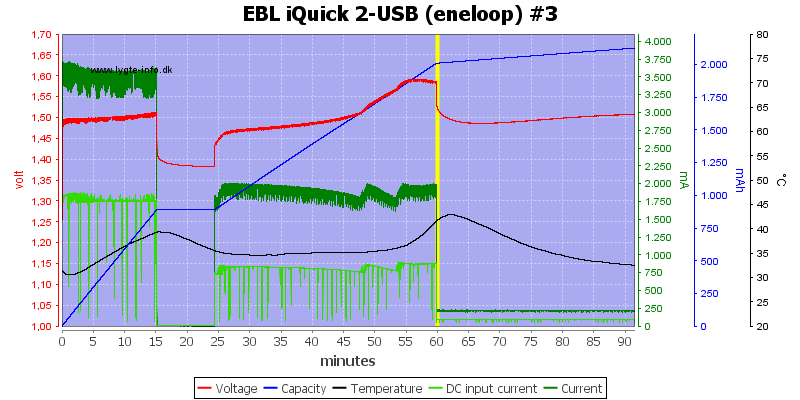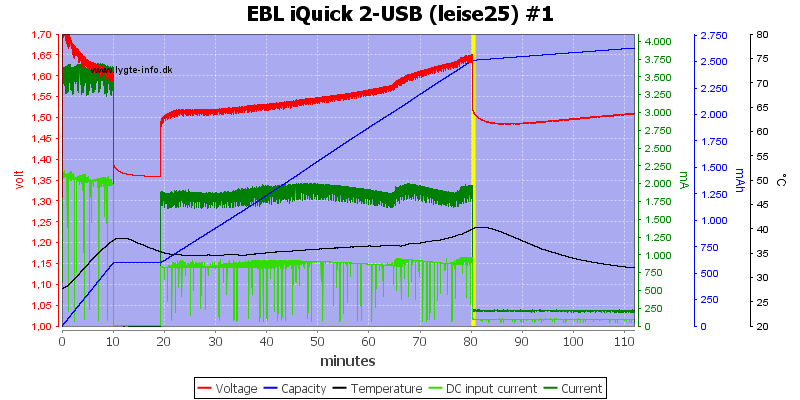EBL iQuick 2-USB charger



This is a simple NiMH AA/AAA charger from EBL, it is USB powered.





I got the charger in a cardboard box with some warnings and instructions on it.

The pack contained the charger, a instruction sheet and a USB cable (A to micro).

The charger can be powered from both micro USB and USB-C

Only user interface is a led for each slot. It is a green and red led and will show green when the charger is empty or when batteries are charged and flash green while charging. When a battery is put into the charger it will use combinations of red/green/flashing to show the power level of the battery.



The charger has the typically two level slots used for AA and AAA batteries.
Notice the metal pad at the bottom of the slots, it is probably a temperature sensor.

The charger has a hole in the bottom, this makes it very easy to push batteries out of the charger. There is also some specifications on the bottom.




Measurements charger
-
Old batteries (i.e. high internal resistance) will not be charged, but the led will flash red.
-
When not powered it will discharge with less than 0.15mA
-
The charger has one charger circuit, it will be time shared between slots.
-
Power consumption when idle is 6.5mA from USB
-
USB-A and USB-C both uses 5V and same input current.

This is a very fast charge when charging a single cell, the current is around 3.6A, at least for some of the time (Maybe temperature controlled). After some time the charger takes a 10 minute break and resume at a lower charge current. The termination looks like -dv/dt. When done with charging it will continue with trickle charging at a fairly high level of 220mA



The 3 other slots looks similar.

I did not see any time limits on the trickle charging.

The eneloop Pro is older, this means higher internal resistance and higher charge voltage, they where charged fine enough.

The same with the leise batteries, but this is not a -dv/dt termination and the termination is at lower voltage than the eneloop Pro. This means it cannot be a standard voltage termination either.

With AAA the charger current is lower (around 1.8A), but still rather high. Here the charger did not need a break during charging.

With two batteries in the charger the current is halved, by using time sharing.

With four batteries the current is a quarter, again done with time sharing.

M1: 42.9°C, M2: 45.7°C, M3: 43.9°C, M4: 37.9°C, HS1: 55.6°C

HS1: 55.9°C

The charger only needs about two second to start and will turn current off to measure voltage. For this charger I had to use a smaller current sense resistor (\<100mOhm) and I did not bother with calibrating the current readout.

If the battery has to high internal resistance the charger will stop and flash the red led.
The charger cannot reach full current here due to the high resistance. In this case the problem was my test equipment, not the battery, but I saw the same behaviour with some old batteries.

With two batteries in the charger it will use full current, but switch between the slots, this means the effective charge rate is halved

With four batteries the time sharing is 1/4 time for each slot.

After the break the charger will use lower current.

The charger is not very good with unstable supply, it has two problems:
At some voltages it lock up and will not charge anymore.
When voltage increases it is slow to adjust current and will draw a very high current for a short time. The 5A is limited by my supply, not by the charger.
Conclusion
This charger is fast especially when only charging 1 battery, this fast charging will be hard on the batteries. It is good at terminating at the correct time, but I do not like the high trickle charge.
It is a fairly good charge, if a shorter battery life can be accepted.
Notes
Here is an explanation on how I did the above charge curves: How do I test a charger